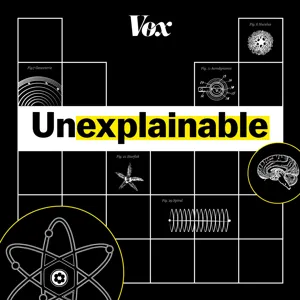Podcast Summary
Genetically resurrecting extinct traits in living species: While genetic engineering holds promise for bringing extinct traits back, ethical and ecological implications must be considered.
While advancements in genetic engineering hold promise for bringing extinct traits back in living species, it's important to consider the ethical and ecological implications. Apple Card offers daily cashback and savings opportunities, while State Farm Small Business Insurance caters to small business owners with personalized policies. Colossal, a company aiming to genetically resurrect woolly mammoths, is actually working on creating elephants with mammoth-like traits for potential benefits to ecosystems and various industries. However, the debate over the morality and feasibility of such projects continues, with scientists and experts expressing concerns and skepticism. It's essential to weigh the potential benefits and risks before moving forward.
Understanding Extinct DNA for the Past and Present: Researchers study ancient DNA to learn about the past and protect current species, while public fascination revolves around resurrecting extinct animals. Fragmented DNA from frozen remains requires advanced technology to extract and decipher, potentially leading to valuable insights for current species.
While researchers like Beth Shapiro focus on studying ancient DNA to understand the past and protect current species, the public's fascination often revolves around the possibility of bringing extinct animals back to life, such as mammoths. Although it's not currently possible, advancements in technology might make resurrecting extinct DNA and even traits a reality in the future. Researchers collect well-preserved samples from frozen remains, like mammoth bones, which are abundant in areas like the Arctic. However, the DNA from these samples is not in the same condition as modern DNA. It's more fragmented and needs advanced technology to be extracted and deciphered. While the ultimate goal isn't to bring back extinct animals, understanding their DNA could lead to valuable insights and potential benefits for current species.
Bringing Extinct Animals Back to Life: Scientists aim to increase biodiversity by editing DNA of living relatives and cloning extinct animals, focusing on specific genes to help them adapt to their extinct environments
Scientists are working on bringing extinct animals back to life through advanced genetic engineering and cloning techniques. They are focusing on editing the DNA of living relatives, like the Asian elephant, to make it more similar to the extinct animal's DNA. Once they have edited the DNA, they clone the animal using the same process that brought us Dolly the sheep. However, editing an entire genome is currently beyond their reach, so they focus on specific genes that could help the animal adapt to its extinct environment. The ultimate goal is to increase biodiversity and potentially save endangered species. For instance, the black-footed ferret project aims to resurrect extinct lineages and introduce them into the living population to increase genetic diversity. Despite predictions of having a mammoth-like elephant by 2027, the process is complex and progress may take longer than anticipated.
Bringing extinct species back through gene editing: Gene editing technology can't fully recreate extinct species as experiences, behaviors, and environments also shape organisms. Instead, focus on creating organisms that can thrive in new habitats for ecosystem restoration and resilience.
While gene editing technology holds promise for introducing traits from extinct species into living ones to help them adapt to changing habitats, it's important to remember that organisms are more than just their DNA sequences. Experiences, behaviors, and environments all play a role in shaping an organism. Therefore, even with advanced technology, we cannot fully recreate an extinct species. Instead, the goal should be to create organisms that can thrive in their new habitats and contribute to ecosystem restoration and resilience. Colossal, a company at the forefront of this technology, is working on projects to bring back extinct animals like the mammoth, Tasmanian tiger, and even the dodo, with the ultimate goal of reintroducing them into their natural habitats. However, the ethical implications of such endeavors are complex and ongoing debates within the scientific community.
Bringing back the extinct dodo bird using gene editing: Scientists are exploring gene editing technology to resurrect the dodo bird by editing primordial germ cells and injecting them into bird embryos, potentially contributing to conservation efforts.
Scientists are working on bringing back the extinct dodo bird using gene editing technology, specifically by editing the DNA of primordial germ cells and injecting them into a bird embryo. This process would result in offspring that carry the edited genes, passing them on to future generations. While the technical challenge of cloning birds is the lack of access to egg cells at the right developmental stage, this innovative approach could potentially lead to the resurrection of the dodo and contribute to bird conservation efforts. Despite the excitement, it's important to remember that traditional conservation methods should not be overlooked.
Reviving Extinct Species Brings Funds for Conservation: De-extinction project could bring new funds to conservation efforts, leading to innovative tools and techniques, but also raises ethical concerns and potential risks of introducing invasive species.
The de-extinction project by Colossal, which aims to bring extinct species back through genetic engineering, is not only about reviving extinct animals but also about bringing new funds to conservation efforts. This influx of investment could lead to the development of innovative tools and techniques that can be applied to present-day conservation projects. However, there are potential downsides, such as the possibility of introducing invasive species or ethical concerns. It's important to remember that the process is long-term and will involve careful planning, stakeholder engagement, and observation of the animals in controlled environments before they can be released into the wild. Beth Shapiro, a scientist who was initially skeptical of the project, now sees it as a way to advance conservation technology and prevent further extinctions. It's crucial to clarify that the goal is not to bring back extinct animals in their entirety but to create species that are adapted to their environments. Overall, the de-extinction project offers both opportunities and challenges for conservation and should be approached with careful consideration.
Understanding the complexities of de-extinction: Scientific skepticism and embracing confusion surround the term 'de-extinction'. Potential benefits for conservation, but concerns about impact, funding, and public perception.
While the potential of bringing extinct species back to life through biotechnology is an exciting prospect, it's important to acknowledge the semantic complexities and potential limitations of such an endeavor. Beth Shapiro, a molecular evolutionary biologist, shares her perspective on the tension between scientific skepticism and embracing the confusion surrounding the term "de-extinction." She acknowledges the potential benefits for conservation but also raises concerns about the certainty of its impact, the potential impact on funding for other conservation efforts, and the public perception of DNA as the sole solution to bringing back extinct species. Tori Harridge, a paleobiologist, shares similar views, expressing skepticism about the potential impact on the environment and the potential for the technology to overshadow other conservation efforts. Ultimately, while the prospect of de-extinction is intriguing, it's essential to approach it with a nuanced understanding of its potential benefits and limitations.
The dream of de-extinction: Despite the challenges, discussing de-extinction serves as a reminder of the harm humans have caused and the need for action to restore the natural world.
While the prospect of bringing back extinct species through de-extinction technology is an intriguing idea, it is not a quick or easy solution to the extinction crisis. The process of sequencing and editing the DNA of extinct animals is currently impossible due to the lack of preserved DNA older than a million years. For instance, dinosaurs have been extinct for over 65 million years, making their resurrection a distant dream. However, discussing de-extinction serves as a reminder of the immense harm humans have caused to the natural world and the vast amount of work required to restore it. The term "de-extinction" symbolizes the immense scale of the crisis and the importance of addressing it. While it may not be a solution, it can serve as a wake-up call to the magnitude of the damage and the need for action. The episode "Unexplainable" explored the possibility of de-extinction through the example of the mammoth, and while it remains uncertain if this technology will bear fruit, the hope and the discussion around it are significant.






